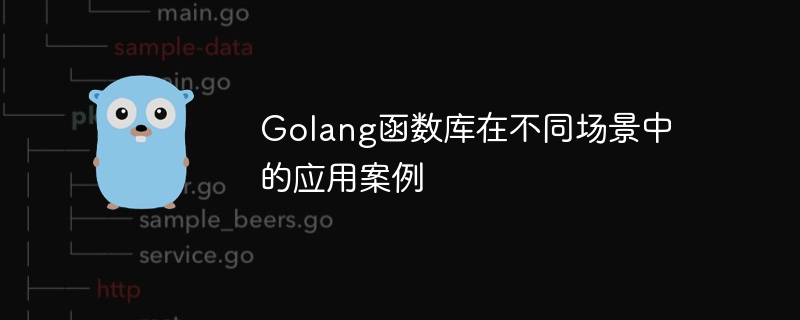Golang函式庫在不同場景中的應用案例
Go 標準函數庫具有廣泛的應用場景,例如:解析 CSV 資料。發出 HTTP 請求。管理並發協程。序列化和反序列化自訂結構體。取得作業系統資訊。這些函數庫簡化了開發過程,提高了生產力和可靠性。

Go 函數庫在不同場景中的應用案例
Go 語言豐富且強大的標準函數庫提供了適用於各種場景的工具和特性。本文將介紹一些 Go 函數庫的實用應用案例,展示其在實際專案中的用途。
1. 資料處理
-
#CSV 讀取與解析:使用
encoding/csv套件來解析從CSV 檔案載入的數據,並將其儲存在自訂資料結構中。import ( "encoding/csv" "io" ) func parseCSV(r io.Reader) ([]map[string]string, error) { csvReader := csv.NewReader(r) records, err := csvReader.ReadAll() if err != nil { return nil, err } header := records[0] data := make([]map[string]string, len(records)-1) for i := 1; i < len(records); i++ { data[i-1] = make(map[string]string) for j := 0; j < len(records[i]); j++ { data[i-1][header[j]] = records[i][j] } } return data, nil }登入後複製
2. 網路操作
#HTTP 請求傳送:使用
net /http套件發出HTTP 請求並從遠端伺服器接收回應。import ( "fmt" "net/http" ) func makeRequest(url string) (*http.Response, error) { resp, err := http.Get(url) if err != nil { return nil, err } defer resp.Body.Close() if resp.StatusCode != http.StatusOK { return nil, fmt.Errorf("bad response status: %s", resp.Status) } return resp, nil }登入後複製
3. 並發程式設計
#協程建立與管理:使用
sync和context套件建立和管理並發協程,以提高應用程式效能。import ( "context" "sync" ) func concurrentTask(ctx context.Context, wg *sync.WaitGroup) { // 并发任务 defer wg.Done() } func main() { var wg sync.WaitGroup ctx, cancel := context.WithCancel(context.Background()) for i := 0; i < 10; i++ { wg.Add(1) go concurrentTask(ctx, &wg) } // 在所有协程完成之前等待 wg.Wait() // 取消所有剩余的协程 cancel() }登入後複製
4. 序列化與反序列化
#自訂結構體編/解碼: 使用
encoding/json套件來序列化和反序列化自訂結構體,實現資料傳輸和持久化。import "encoding/json" type User struct { Name string Age int } func encodeJSON(u User) ([]byte, error) { return json.Marshal(u) } func decodeJSON(data []byte) (User, error) { var u User err := json.Unmarshal(data, &u) return u, err }登入後複製
5. 系統實用工具
作業系統資訊取得:使用
runtime套件取得有關作業系統和目前執行時間環境的資訊。import "runtime" func getSystemInfo() (string, string) { return runtime.GOOS, runtime.GOARCH }登入後複製
這些案例展示了 Go 函數庫如何為各種場景提供有用的工具,消除了重複編碼的需要,並 簡化了開發過程。透過利用這些函數庫,開發者可以專注於業務邏輯,提高生產力並建立更健壯可靠的應用程式。
以上是Golang函式庫在不同場景中的應用案例的詳細內容。更多資訊請關注PHP中文網其他相關文章!

熱AI工具

Undresser.AI Undress
人工智慧驅動的應用程序,用於創建逼真的裸體照片

AI Clothes Remover
用於從照片中去除衣服的線上人工智慧工具。

Undress AI Tool
免費脫衣圖片

Clothoff.io
AI脫衣器

Video Face Swap
使用我們完全免費的人工智慧換臉工具,輕鬆在任何影片中換臉!

熱門文章

熱工具

記事本++7.3.1
好用且免費的程式碼編輯器

SublimeText3漢化版
中文版,非常好用

禪工作室 13.0.1
強大的PHP整合開發環境

Dreamweaver CS6
視覺化網頁開發工具

SublimeText3 Mac版
神級程式碼編輯軟體(SublimeText3)
 如何使用 Golang 安全地讀取和寫入檔案?
Jun 06, 2024 pm 05:14 PM
如何使用 Golang 安全地讀取和寫入檔案?
Jun 06, 2024 pm 05:14 PM
在Go中安全地讀取和寫入檔案至關重要。指南包括:檢查檔案權限使用defer關閉檔案驗證檔案路徑使用上下文逾時遵循這些準則可確保資料的安全性和應用程式的健全性。
 如何為 Golang 資料庫連線配置連線池?
Jun 06, 2024 am 11:21 AM
如何為 Golang 資料庫連線配置連線池?
Jun 06, 2024 am 11:21 AM
如何為Go資料庫連線配置連線池?使用database/sql包中的DB類型建立資料庫連線;設定MaxOpenConns以控制最大並發連線數;設定MaxIdleConns以設定最大空閒連線數;設定ConnMaxLifetime以控制連線的最大生命週期。
 如何在 Golang 中將 JSON 資料保存到資料庫中?
Jun 06, 2024 am 11:24 AM
如何在 Golang 中將 JSON 資料保存到資料庫中?
Jun 06, 2024 am 11:24 AM
可以透過使用gjson函式庫或json.Unmarshal函數將JSON資料儲存到MySQL資料庫中。 gjson函式庫提供了方便的方法來解析JSON字段,而json.Unmarshal函數需要一個目標類型指標來解組JSON資料。這兩種方法都需要準備SQL語句和執行插入操作來將資料持久化到資料庫中。
 Golang框架與Go框架:內部架構與外部特性對比
Jun 06, 2024 pm 12:37 PM
Golang框架與Go框架:內部架構與外部特性對比
Jun 06, 2024 pm 12:37 PM
GoLang框架與Go框架的差異體現在內部架構與外部特性。 GoLang框架基於Go標準函式庫,擴充其功能,而Go框架由獨立函式庫組成,以實現特定目的。 GoLang框架更靈活,Go框架更容易上手。 GoLang框架在效能上稍有優勢,Go框架的可擴充性更高。案例:gin-gonic(Go框架)用於建立RESTAPI,而Echo(GoLang框架)用於建立Web應用程式。
 從前端轉型後端開發,學習Java還是Golang更有前景?
Apr 02, 2025 am 09:12 AM
從前端轉型後端開發,學習Java還是Golang更有前景?
Apr 02, 2025 am 09:12 AM
後端學習路徑:從前端轉型到後端的探索之旅作為一名從前端開發轉型的後端初學者,你已經有了nodejs的基礎,...
 golang框架開發實戰教學:常見疑問解答
Jun 06, 2024 am 11:02 AM
golang框架開發實戰教學:常見疑問解答
Jun 06, 2024 am 11:02 AM
Go框架開發常見問題:框架選擇:取決於應用需求和開發者偏好,如Gin(API)、Echo(可擴展)、Beego(ORM)、Iris(效能)。安裝和使用:使用gomod指令安裝,導入框架並使用。資料庫互動:使用ORM庫,如gorm,建立資料庫連線和操作。身份驗證和授權:使用會話管理和身份驗證中間件,如gin-contrib/sessions。實戰案例:使用Gin框架建立一個簡單的部落格API,提供POST、GET等功能。
 Go語言中哪些庫是由大公司開發或知名的開源項目提供的?
Apr 02, 2025 pm 04:12 PM
Go語言中哪些庫是由大公司開發或知名的開源項目提供的?
Apr 02, 2025 pm 04:12 PM
Go語言中哪些庫是大公司開發或知名開源項目?在使用Go語言進行編程時,開發者常常會遇到一些常見的需求,�...
 Golang的目的:建立高效且可擴展的系統
Apr 09, 2025 pm 05:17 PM
Golang的目的:建立高效且可擴展的系統
Apr 09, 2025 pm 05:17 PM
Go語言在構建高效且可擴展的系統中表現出色,其優勢包括:1.高性能:編譯成機器碼,運行速度快;2.並發編程:通過goroutines和channels簡化多任務處理;3.簡潔性:語法簡潔,降低學習和維護成本;4.跨平台:支持跨平台編譯,方便部署。






